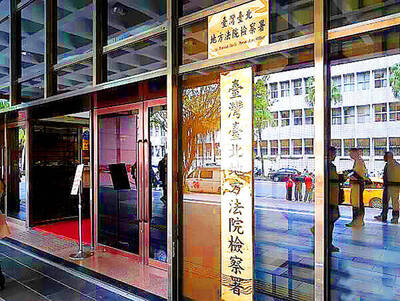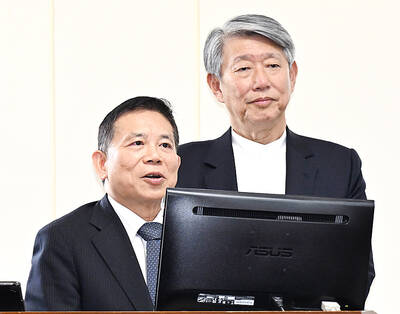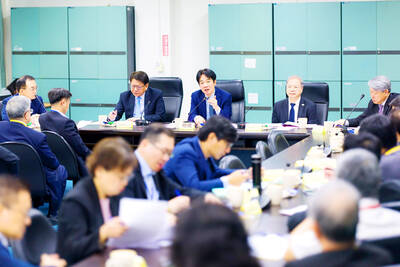The suffocating smog that blanketed swathes of China is now hitting parts of Japan, sparking warnings yesterday of health risks for the young and the sick.
The Japanese Ministry of the Environment’s Web site has been overloaded as worried users log on to try to find out what is coming their way.
“Access to our air pollution monitoring system has been almost impossible since last week and the telephone here has been constantly ringing because worried people keep asking us about the impact on health,” a ministry official said.
Pictures of Beijing and other Chinese cities shrouded in thick, choking smog played out across television screens in Japan last week.
News programs have broadcast maps showing a swirl of pollution gathering strength across China and then spreading out over the ocean toward Japan.
Pinks, reds and oranges that denote the highest concentrations form a finger of smog that inches upward to the main southern island of Kyushu.
Relations between Tokyo and Beijing are already strained, over the sovereignty of the Diaoyutai Islands (釣魚台), claimed by Taiwan, China and Japan, which calls them the Senkakus. On the streets of Tokyo, reaction was tart.
“China is our neighbor and all sorts of problems happen between us all the time,” Takaharu Abiko, 50, said. “It is very worrying. This is dangerous pollution, like poison, and we can’t protect ourselves. It’s scary.”
Japanese officials were coy about lumping all the blame on their huge neighbor, but Yasushi Nakajima of the environment ministry said: “We can’t deny there is an impact from pollution in China.”
Air pollution over the west of Japan has exceeded government limits over the past few days, with tiny particulate matter a problem, Atsushi Shimizu of Japan’s National Institute for Environmental Studies (NIES) said.
Prevailing winds from the west bring airborne particles from the Asian mainland, he said.
Of specific concern is the concentration of particles 2.5 micrometers or less in diameter, which has been as high as 50 micrograms per cubic meter of air over recent days in northern Kyushu. The government’s safety limit is 35 micrograms.
Yellow sand from the deserts of Mongolia and China is a known source of these particles, as are exhausts from cars and smoke from factories.
“At this time of year they are definitely not yellow sand, so they’re toxic particles,” Shimizu said, adding that “people with respiratory diseases should be careful.”
Toshihiko Takemura, an associate professor of Kyushu University who runs another air pollution monitoring site, said “the impact of air pollution originating from China on Japan was scientifically discovered more than a decade ago.”
“Especially in Kyushu, the level of air pollution has been detectable in everyday lives since a few years ago,” he told reporters. “People in eastern and northern Japan are now belatedly noticing the cross-border air pollution.”
Takemura added that pollution in Japan over the past few days has not been quite as bad as it was in February 2011, when “very hazy days continued for several days in western Japan.”

INVESTIGATION: The case is the latest instance of a DPP figure being implicated in an espionage network accused of allegedly leaking information to Chinese intelligence Democratic Progressive Party (DPP) member Ho Jen-chieh (何仁傑) was detained and held incommunicado yesterday on suspicion of spying for China during his tenure as assistant to then-minister of foreign affairs Joseph Wu (吳釗燮). The Taipei District Prosecutors’ Office said Ho was implicated during its investigation into alleged spying activities by former Presidential Office consultant Wu Shang-yu (吳尚雨). Prosecutors said there is reason to believe Ho breached the National Security Act (國家安全法) by leaking classified Ministry of Foreign Affairs information to Chinese intelligence. Following interrogation, prosecutors petitioned the Taipei District Court to detain Ho, citing concerns over potential collusion or tampering of evidence. The

NEGOTIATIONS: Taiwan has good relations with Washington and the outlook for the negotiations looks promising, Minister of Economic Affairs J.W. Kuo said Taiwan’s GDP growth this year is expected to decrease by 0.43 to 1.61 percentage points due to the effects of US tariffs, National Development Council (NDC) Minister Paul Liu (劉鏡清) said at a meeting of the legislature’s Economics Committee in Taipei yesterday, citing a preliminary estimate by a private research institution. Taiwan’s economy would be significantly affected by the 32 percent “reciprocal” tariffs slapped by the US, which took effect yesterday, Liu said, adding that GDP growth could fall below 3 percent and potentially even dip below 2 percent to 1.53 percent this year. The council has commissioned another institution

NEGOTIATIONS: The US response to the countermeasures and plans Taiwan presented has been positive, including boosting procurement and investment, the president said Taiwan is included in the first group for trade negotiations with the US, President William Lai (賴清德) said yesterday, as he seeks to shield Taiwanese exporters from a 32 percent tariff. In Washington, US Trade Representative Jamieson Greer said in an interview on Fox News on Thursday that he would speak to his Taiwanese and Israeli counterparts yesterday about tariffs after holding a long discussion with the Vietnamese earlier. US President Donald Trump on Wednesday postponed punishing levies on multiple trade partners, including Taiwan, for three months after trillions of US dollars were wiped off global markets. He has maintained a 10 percent

TRADE: The premier pledged safeguards on ‘Made in Taiwan’ labeling, anti-dumping measures and stricter export controls to strengthen its position in trade talks Products labeled “made in Taiwan” must be genuinely made in Taiwan, Premier Cho Jung-tai (卓榮泰) said yesterday, vowing to enforce strict safeguards against “origin laundering” and initiate anti-dumping investigations to prevent China dumping its products in Taiwan. Cho made the remarks in a discussion session with representatives from industries in Kaohsiung. In response to the US government’s recent announcement of “reciprocal” tariffs on its trading partners, President William Lai (賴清德) and Cho last week began a series of consultations with industry leaders nationwide to gather feedback and address concerns. Taiwanese and US officials held a videoconference on Friday evening to discuss the